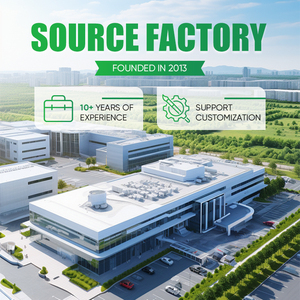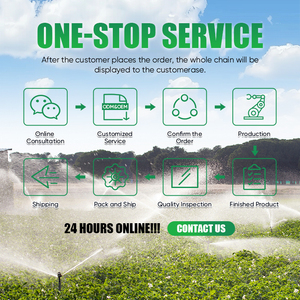(4326 products available)
























































































































































































































The direct irrigation system is a method of watering plants by delivering water directly to the plant's roots. This system is practical for both small and large-scale agricultural operations. Here are some of its types:
Drip irrigation
It delivers water directly to the roots through a network of tubing and emitters. Water is released drop by drop, reducing evaporation and ensuring plants get enough water. It is suitable for all types of plants, including delicate ones.
Sprinkler irrigation
It sprays water into the air and falls like natural rain. It is done using pipes, pumps, and sprinklers. It is suitable for many crops and gardens and is efficient for uneven land.
Soaker hose irrigation
It is made of porous materials that allow water to seep out along the entire length of the hose. When the hose is placed on or buried under the soil surface, it provides a slow, steady supply of moisture directly to the plant roots. It is ideal for gardens, flower beds, and rows of vegetables.
Subsurface irrigation
It involves placing the irrigation tubing or drip lines below the soil surface. This method is appropriate for sandy and loam soils. It minimizes water loss due to evaporation and reduces weed growth.
Surface irrigation
This method involves distributing water over the soil surface and allowing it to flow across the field by gravity. It is simple and inexpensive, suitable for level fields and crops with moderate water requirements.
Manual watering can irrigation
Using a watering can is a simple and traditional method for irrigating small gardens or individual plants. The watering can allows for precise control over the amount of water given to each plant. It's an effective way to ensure that plants receive the right amount of water but can be labor-intensive for larger gardens or areas.
A direct irrigation system is a method of watering plants, crops, or gardens that delivers water directly to the root zone of the plant. This can be achieved through various techniques and systems, such as drip irrigation systems. The design of a direct irrigation system can be modified to meet specific needs, preferences, and environmental conditions. Here are some critical components of the system.
Water source:
The water source can be any source of water such as a well, pond, river, municipal water supply, or storage tank. The water source is the starting point of a direct irrigation system. It provides the essential water needed for irrigation.
Conveyance system:
This carries water from the water source to the area that needs irrigation. It can be pipes, channels, tubes, or hoses. In some systems, like drip irrigation, it includes mainlines and sub-mainlines that transport water to the laterals.
Distribution system:
The distribution system delivers water directly to the plants. This can include:
- Drip lines or soaker hoses in drip or soaker systems that release water close to the ground.
- Sprinklers or spray heads in sprinkler systems that send water through the air to cover a larger area.
Control system:
A control system manages when and how much water is distributed in the irrigation system. It can be manual or automatic. Timers and sensors are part of automatic systems. They turn the system on or off based on specific schedules or soil moisture levels.
Emitters:
Emitters are devices that release water from the irrigation system directly to the plants. In drip systems, they control the flow and deliver water to individual plants.
Connectors and fittings:
They are essential parts of any irrigation system. They are used to join different components, such as pipes, tubes, drip lines, and hoses. They ensure a tight and leak-free connection.
Filters:
They remove dirt and debris from the water to prevent clogs in the system. They ensure smooth water flow through the pipes, tubes, and emitters.
Pressure regulators:
Regulators control water pressure in the system. They ensure that emitters and other components work efficiently and do not get damaged due to high pressure.
The scenario for which a direct irrigation system is intended determines its design and implementation. Different situations require different approaches to irrigation. The following scenarios highlight how various aspects of irrigation systems can be applied:
Commercial vegetable farms
A commercial vegetable farm planning to grow different crops all year needs a direct irrigation system that can be changed for each crop's water needs. Drip irrigation works well for this scenario since it delivers water directly to the plant roots and can be adjusted according to different vegetables' water requirements.
Greenhouse horticulture
A greenhouse horticulture operation growing delicate flowers and plants throughout the year regardless of outside weather conditions requires a direct irrigation system that maintains consistent moisture levels in the controlled environment of the greenhouse. For this situation, a timed drip irrigation system that automatically provides the right amount of water at set intervals would be ideal.
Orchard management
An orchard owner cultivating fruit trees such as apples, oranges, and peaches needs to ensure their trees get enough water without overwatering them, which can damage them. In this case, a direct irrigation system like a soaker hose that slowly releases water into the soil along its length, soaking it up, is suitable because it prevents water from splashing onto leaves or fruits.
Landscape irrigation
A landscaping business designing yards and gardens for house owners wants to provide a direct irrigation system that evenly distributes water over various plants in different areas. Here, a sprinkler irrigation system that sprays water over a wide area, covering both grass and plants at once, works best.
Urban agriculture
An urban agriculture project growing vegetables on rooftops and vacant lots in the city requires a direct irrigation system that conserves water due to limited space available for farming in an urban setting where water conservation is crucial. The best option here is a vertical garden irrigation system using rainwater collected from rooftops, conserving water while irrigating plants vertically, saving space.
When choosing a direct irrigation system, there are many factors to consider. They will help users select the best system to meet their needs. Users should consider the type of crop being grown. Different crops have other water needs and root depths. For instance, deep-rooted trees may require a different system than surface-level vegetable crops. The system should accommodate their needs. Evaluate the water source and its availability. Is it constant or limited? Systems like drip irrigation, which conserve water, are ideal for areas with scarce water supplies. Users should also consider the soil type. Sandy soils drain quickly and may require more frequent watering. Clay soils retain water and may need less frequent watering. The irrigation system components should suit the soil.
Consider the budget, both for the initial setup and the long-term operational costs. Some systems may have a high upfront cost but save money over time due to reduced water usage. For example, automated systems may be more expensive initially but can save labor costs in the long run. Evaluate the ease of maintenance and the required labor. Systems that are easy to maintain and require less labor are preferable, especially for those with limited resources. Users should also consider the scalability and flexibility of the system. Can it be expanded as the farm grows? Can it be adapted to changing weather patterns or crop rotations? The best systems are those that can adjust to future needs.
Lastly, think about the environmental impact. Systems that conserve water and reduce energy usage are not only better for the environment but may also be supported by government incentives. Choose a direct irrigation system that aligns with sustainability goals. In conclusion, choosing a direct irrigation system requires a thorough assessment of various factors, including crop needs, water source, soil type, budget, maintenance, scalability, and environmental impact. By considering these factors, users can select a system that will improve crop yields and conserve water. They are crucial for sustainable agriculture.
Q1: What are the benefits of a direct irrigation system?
A1: The main advantages of direct irrigation systems are water conservation, efficient watering, reduced weed growth, and improved plant health.
Q2: What types of crops are suitable for a direct irrigation system?
A2: All crops can benefit from direct irrigation systems, but high-value, water-sensitive ones will gain the most.
Q3: How does a direct irrigation system save water?
A3: This system delivers water straight to the plant roots, minimizing evaporation and runoff.
Q4: Can direct irrigation be used in all soil types?
A4: Direct irrigation suits all soil types; however, the system may need to be adjusted according to the soil's water-holding capacity.
Q5: What is the lifespan of a direct irrigation system?
A5: The lifespan varies depending on the system components, but most can last 10 to 30 years with proper maintenance.
The web search volume for the keyword "direct irrigation system" in the Home & Garden category has shown remarkable stability over the past year. With an average monthly web search volume of 10, the keyword has experienced zero percent change both in the last three months and over the past year. The detailed monthly data from December 2023 to November 2024 consistently reflects this steady interest, with the exception of April 2024 when web searches dipped to zero.
Analyzing the trend, it is evident that interest in direct irrigation systems is relatively niche and does not fluctuate significantly with seasonal changes or market trends. The consistent web search volume, barring the April anomaly, suggests a dedicated but small user base. This could indicate that the target audience is well-defined and possibly limited to specific regions or professional sectors within the gardening and agriculture community.
The stability of web search volume for "direct irrigation system" could also be attributed to its specialized nature. Unlike broader gardening topics, which might see spikes during planting seasons or due to viral gardening tips, this keyword represents a specific technology or method that might not gain widespread popularity but maintains a steady relevance for its intended users. This analysis highlights the importance of understanding niche markets and their consistent needs, which can be crucial for businesses and marketers in the Home & Garden sector.